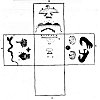
Click to enlarge
Plate 10, Figure 1

Click to enlarge
Plate 10, Figure 1
FIGURE 1. Kiva floor and murals. Central panel shows floor with medicine men (X X X) sitting behind altar, with shipapu kuwatsaishuma (O), medicine bowl (
 ), tsiwaimitiima (
), tsiwaimitiima (
 ), fireplace (
), fireplace (
 ), ladders (
), ladders (
 ). North wall: Flint bird (white with black and brown dots, legs and tail brown), Clouds (upper three, white; lower three, orange, blue, red) and lightning (red) over field (orange). West wall: Water snake (brown) (killed by the Twins), Tsitsanits katsina (half blue, half black; forehead black divided by red triangle, horns green), Oshach katsina (blue face, green forehead, feather top piece); star (brown). South wall always left blank. East wall: Bears (left, black; right, brown) (note hearts, also two shamanistic eagle feathers in left paw); Kopishtaiya, Sun (red, with black "rays"); Kopishtaiya katsina (see pl. 5, fig. 2); Tsiukiri katsina (see pl. 3, fig. 2). People sit in an are around south, southeast, and southwest walls.
). North wall: Flint bird (white with black and brown dots, legs and tail brown), Clouds (upper three, white; lower three, orange, blue, red) and lightning (red) over field (orange). West wall: Water snake (brown) (killed by the Twins), Tsitsanits katsina (half blue, half black; forehead black divided by red triangle, horns green), Oshach katsina (blue face, green forehead, feather top piece); star (brown). South wall always left blank. East wall: Bears (left, black; right, brown) (note hearts, also two shamanistic eagle feathers in left paw); Kopishtaiya, Sun (red, with black "rays"); Kopishtaiya katsina (see pl. 5, fig. 2); Tsiukiri katsina (see pl. 3, fig. 2). People sit in an are around south, southeast, and southwest walls.

Click to enlarge
Plate 10, Figure 2
FIGURE 2. Altar sand paintings. a, Fire society altar: The rim (blue) is the sky; the upper crescent contains the symbols for the sun (red), moon (yellow), and stars; the arc (pale gray) is the Milky Way; the face (yellow with black hair) below, Iatiku; and the spots (yellow) represent the earth; the triangular object (red) on breast is the heart, the center of the earth and the center of the picture. b, Ant society altar: Circle (pale gray) and spots (yellow) are of corn meal; star, blue; sun, red; moon, yellow. The lizard (green with 4 bands--yellow, blue, red, white--around throat) can eat ants and gives power to cure a person afflicted with itching caused by ants.